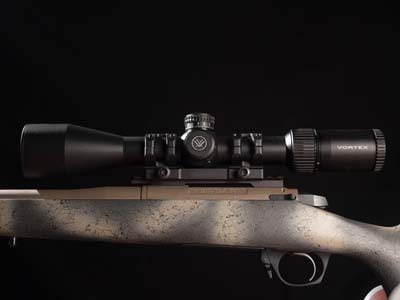Managing Editor
Long-range shooting is defined as shooting at ranges that require significant ballistic computation in order to adjust your zero to impact your target. There is no set range that differentiates regular aimed shooting from long-range, but it is more about the process of computing a supersonic projectile’s point of impact based on the many variables that must be accounted for. Shooting at distances greater than the supersonic range of the projectile are categorized as extended long-range. At extended long-ranges, the computations get trickier as you must compute many more variables that exist in a transonic bullet than in a supersonic one.
 The hallmark for long-range and extended long-range shooting has been a scope whose reticle will increase in size with the magnification and that is also calibrated to provide an accurate measuring scale, depending on how the reticle is magnified. This allows the shooter to use the subtensions (calibrated measurements of the lines in the reticle that cover a specified distance at a specific range) on his reticle as a measuring tape on the target and have them adjust depending on the range and magnification of the scope. At distances too far to walk and measure, this saves a lot of hiking to the target to measure in order to make adjustments to your scope that translate into precision windage and elevation tweaks.
The hallmark for long-range and extended long-range shooting has been a scope whose reticle will increase in size with the magnification and that is also calibrated to provide an accurate measuring scale, depending on how the reticle is magnified. This allows the shooter to use the subtensions (calibrated measurements of the lines in the reticle that cover a specified distance at a specific range) on his reticle as a measuring tape on the target and have them adjust depending on the range and magnification of the scope. At distances too far to walk and measure, this saves a lot of hiking to the target to measure in order to make adjustments to your scope that translate into precision windage and elevation tweaks.First Focal Plane optics are expensive. The lenses used and the mechanical gearing that allows the reticle to appear larger and smaller and still maintain calibrated distances, makes the cost of building these scopes quite a bit higher than their fixed focal plane or second focal plane counterparts. For those shooting at long-range and extended long-range distances, this type of scope is the Holy Grail and worth every penny.
Even for those who aren’t stretching their rifle out all that far, say within the 400-600-yard range, an FFP scope has great versatility as a measuring device by pairing the subtensions with the parallax adjustment to create a makeshift rangefinder out of your scope.
Vortex took on the challenge to provide an FFP long-range scope available to the everyman shooter for under a thousand bucks. They built it in their Diamondback Tactical line for the designated marksman role.
Featuring 6 times magnification, this 6-24x50mm riflescope provides a host of features you expect from any modern scope, including multicoated glass, inert gas purging, in this case with nitrogen; shockproof; waterproof; and rugged aircraft aluminum alloy construction. These have become the standard for modern riflescopes and you are hard pressed to find any manufacturers who don’t include these features.
 What really sets the Diamondback Tactical apart, other than its FFP reticle, are the low-profile fast adjust tactical turrets for quick adjustment to windage and elevation on the fly without removing covers or needing tools. The turrets can be quickly reset to show zero by simply using a coin or a screwdriver. Nearly five rotations of adjustment (65 MOA) allow you plenty of room for stretching out the distance of your gun in ¼ MOA increments per click.
What really sets the Diamondback Tactical apart, other than its FFP reticle, are the low-profile fast adjust tactical turrets for quick adjustment to windage and elevation on the fly without removing covers or needing tools. The turrets can be quickly reset to show zero by simply using a coin or a screwdriver. Nearly five rotations of adjustment (65 MOA) allow you plenty of room for stretching out the distance of your gun in ¼ MOA increments per click.The wide parallax adjustment knob moves from 10 to 300 yards and then opens up to infinity and is easy to turn. A wide and conveniently located diopter adjustment ring is on the eyepiece.
With 3.9 inches of eye relief, you have less risk of busting your eye socket, especially with the more powerful rifles used for shooting at long-range distances. The 50mm objective lens provides an excellent twilight factor of 34.6 at maximum magnification and 17 at the lowest. It also provides you with a wider view of the battlespace with a field of view of 18-4.5 feet at 100 yards.
And since it is a Vortex, you know it comes with the VIP Warranty that means it will be repaired or replaced if it breaks, no questions asked.
Overall, the Diamondback Tactical 6-24x50 FFP scope is a great performing optic for those looking to break into the sport of long-range shooting or to stretch out their hunting distances. It has the right mix of features to be an effective tool for calculating your adjustments and giving you the precision you need for this exacting pursuit. And it puts this valuable tool in a price range of under $400 that guys like me can afford.

